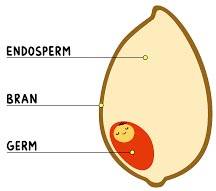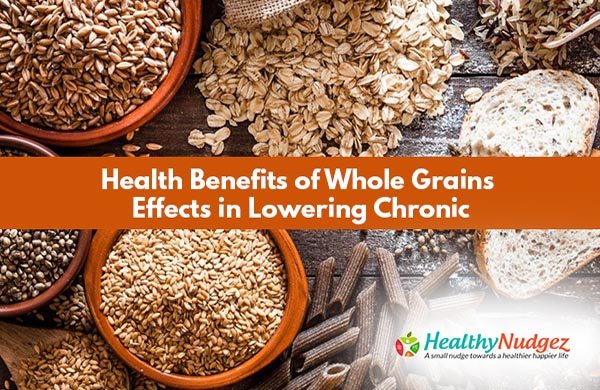Health Benefits of Whole Grains- Effects in Lowering Risk of Chronic Diseases
As humans need a variety of nutrients to lead a healthy active life, the consumption of a balanced diet is one of the main essentials. A well-balanced diet not only helps to prevent malnutrition but is also critical in lowering the risk of developing non-communicable, chronic diseases.
Grains form one of the major part of any diet type. Many researches have proven that whole grain consumption is associated with a great number of health benefits, such as better phytonutrient intake, improved weight management and digestive health as well as reduced risk of chronic diseases, such as obesity, cardio-vascular diseases, diabetes mellitus type 2 and some types of cancers.
Whole grains have been the part of human diet for over 10000 years. During the last about 100 years or so the consumption of refined cereals increased due mainly to industrialization and the invent of various methods of refining. In India the increase in consumption of refined cereals increased also due the influence of the western culture. However, since the early part of this century an emphasis on consumption of whole grains has increased.
 The main components of whole grain are: the nutrient rich core- germ, carbohydrate rich middle layer- endosperm and the fibre rich outer layer- bran.
The main components of whole grain are: the nutrient rich core- germ, carbohydrate rich middle layer- endosperm and the fibre rich outer layer- bran.
Even after processing if the end product contains the above constituents in the same proportion as found in the original grain, it is considered as whole grain.
Whole grains are rich sources of vitamins, minerals, dietary fibre, lignans, β-glucan, inulin, numerous phytochemicals, phytosterols, phytin, and sphingolipids All the three parts of the grain contain important nutrients.
Bran or the outer covering is composed of nondigestible, mainly insoluble, poorly fermentable carbohydrates (such as cellulose, hemicelluloses, arabinoxylan). It is the multi-layer outer skin of the grain and protects the germ and the endosperm from damage through sunlight, pests, water and disease
The endosperm is the largest component of the whole grain; it contains carbohydrates (starch), protein, vitamins, and minerals and serves as the food supply for the germ and provides energy for the rest of the plant.
The inner germ and starchy endosperm also known as the embryo (as it forms the new plant) contain viscous soluble fibres, fermentable oligosaccharides, resistant starch (RS), lignans, vitamins, minerals, polyphenols, oils, and other phytonutrients.
Phytonutrients are non-nutritive components of grains which are bioactive and are associated with reduced risk of chronic diseases. The process of thermal cooking methods can help release these phytochemicals and make them more available and useful to the body. Some of the phytonutrients present in whole wheat are phenolic acids, tocopherols (vitamin E), carotenoids (vitamin A precursors), plant sterols, resistant starch and tannins, to name a few. These phytochemicals are responsible for the health benefits associated with eating whole grains.
Beneficial aspects of Phytonutrients:
Phenolic compounds found in whole grains, such as flavones, caffeic acid, ferulic acid, contribute to protection against colon cancers and cardio-vascular diseases (CVD). These compounds create physical and chemical barriers to combat destructive free radicals and also link with carbohydrates and reduce their absorption from the gut.
Carotenoids also act as anti-oxidants and have provitamin A activity in the body.
Tocopherols along with having an antioxidant property, also help in maintaining cellular membrane integrity. Whole grains also contain certain unsaturated fatty acids such as oleic and linoleic acids, both of which help to lower blood cholesterol levels in the body thus effective in lowering risk of CVD.
The dietary fibre, resistant and oligosaccharides in whole grains contribute to cholesterol reduction, healthy blood glucose and insulin concentrations, improved digestive health, and lower risk of certain gastrointestinal cancers.
Certain anti-nutrients such as phytic acid, tannins and enzyme inhibitors are also present in whole grains and contribute to the overall protective effects of whole grains.
Phytic acid, phenolic acids, and saponins present in whole grain have also been suggested to lower the risk of certain cancers, such as colon cancer and breast cancer.
Phytic acid, lectins, phenolic acids, amylase inhibitors, and saponins have also been shown to lower plasma glucose, insulin, and/or plasma cholesterol and Tri-Glyceride levels
During processing the outer bran and the germ are removed, thus reducing the overall nutritive content of the whole grain by about 80%. Most of the phytonutrients, minerals, vitamins and fibre are removed in the process, thus making the grain nutrient deficient. Only the starchy endosperm remains intact during the refining process thus contributing to the development of chronic diseases.
According to the latest recommendations and dietary guidelines a minimum of 3-4 servings per day (half of the total grain intake) should be of whole grains.
The most common type of whole grains are:
Food products made from whole wheat flour, broken wheat, oats, barley, brown rice, also some of the ready-to-eat products like whole wheat breads, breakfast cereals such as wheat flakes and oats.
It is, therefore, important to include a whole grain cereal at breakfast to improve blood glucose levels and to maintain weight. Including a minimum of one portion of a whole grain in each meal is associated with lowered risks of CVD and cancers.

